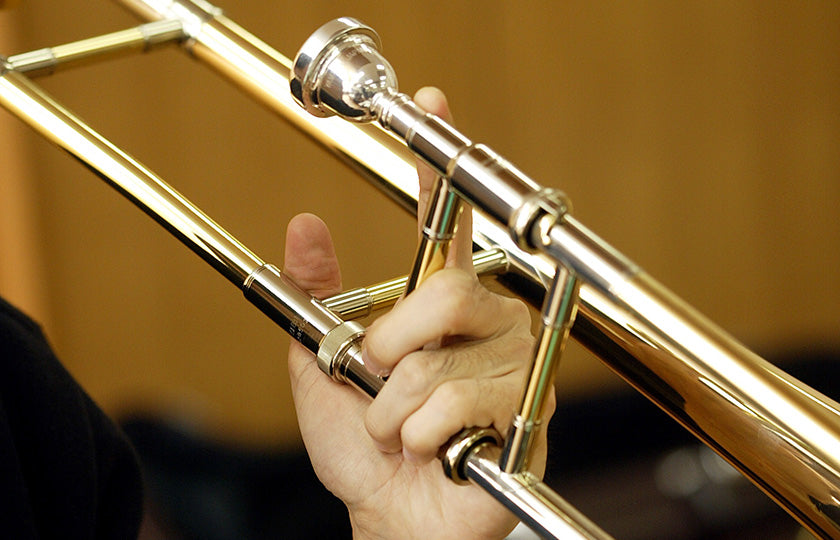
Trombone Learn More
Share

The Structure of the Trombone
Learn the parts of the trombone
The trombone is comprised of the following parts:

* A tenorbass trombone is shown in the diagram.
The Structure of the Trombone
The trombone: The instrument that extends and retracts
How exactly does a trombone extend and retract?
One interesting thing about trombones is how they extend and contract. But what allows these instruments to do so? Put a trombone to your lips and just look straight ahead for your answer: you'll see two parallel tubes right in front of your face. These two tubes (the outer slide and inner slide) form what is called the slide.
Trombones are played by holding the instrument to your lips with your left hand, gripping the brace right in front of your left hand with your right hand, and sliding the slide back and forth. It is therefore extremely important that a trombone's slide moves smoothly.

A trombone is held with the left hand and played with the right hand
Be careful not to drop it!
If you slide the slide out too much it will detach from the instrument. The outer slide and inner slide are just inserted into the instrument; there is nothing holding them in place. Therefore, if you aren't careful and let go of it, the outer slide could fall to the ground under its own weight. The slide is designed like this for a reason: the player needs to be able to slide it back and forth very smoothly to play the instrument.

Just keep this in mind, and be careful not to let the slide drop to the ground!
Totally smooth pitch changes
The slide on a trombone enables the player to change his or her pitch in a truly smooth and "stepless" fashion.
For example, in the piano there is a very clear delineation between C, D, and F. Although any given black key and its neighboring white key have a half-tone difference, a trombone is capable of producing quarter-tones (one half a half-tone) and even eighth-tones (one half of a quarter-tone).
Example of sliding the slide back and forth to vary the pitch
The slide can produce beautiful vibrato
Thanks to its slide, the trombone can produce a very unique vibrato. By finely adjusting the pitch, the player can make the sound appear to "flutter." Vibrato produced from the action of the slide is one of the most recognizable characteristics of the trombone.
Example of vibrato
The Structure of the Trombone
[Experiment]I can only extend my right arm so far!
Can the trombone be comfortably played by women and children?
Each trombone has a maximum slide position it can be played at. For a tenor trombone this is around 60 cm. This is right around the maximum distance that the average Japanese adult male can extend his arm.
However, what if your arms are simply not long enough? One clever way of overcoming this is to attach a string to the slide, allowing you to reach the farthest slide position.
The reason you extend your arm, in the end, is to extend the length of the tube. Trombone manufacturers then came up with an idea. Why not attach another piece of tubing somewhere on the instrument? Doing so would allow the player's breath to pass through this new piece only when needed.
This additional tubing also plays a role in extending the bass range of the trombone. For tenor trombones, this extends the range from B♭ (their fundamental pitch) to A, G, and F. The additional tubing is thus called an "F attachment." A valve must also be installed to use this additional tubing.
This has made it possible for even smaller people to play the trombone.

The coil-like tubing on the inside is the F attachment.The round silver object is the valve.
Does the valve make the instrument easier to play?
The valve makes it easier to play low notes without having to extend your arm as much, and can even be switched out to change the sound completely.
There are even bass trombones with two valves. Turning on and off the two valves gives a total of four combinations, for four different sounds.
Trombone valves were first invented in the 19th century. Until then, it was extremely difficult to play continuously from, say, B♭ to C. Valves now make this easy.
Example of a bass trombone with two valves being played
The Structure of the Trombone
How to play the scale
The slide has seven positions
Trombones work by using the slide to change the length of the tubing, which controls the pitch of the sound. The slide has seven positions, counted in order from the 1st position (toward you) to the 7th position (fully extended). However, there are no position markers on the tubing. Trombone players learn the positions by feel. Although guitars have positions (frets) on their necks, trombones are more like violins, which do not. Trombones are therefore not so unique in terms of position markers (or lack thereof).
Several sounds can be produced from a single position
Just because there are seven slide positions doesn't mean that trombones can only play seven sounds. A trombone can produce several sounds from a single position.
Let's listen to what kinds of sounds can be produced from the 1st position.
Examples of sounds produced from the 1st position
The sounds produced at each position, from 1st to 7th, are shown below, expressed as notes:

Sounds at each position
The mouth is used to vary the sound
A trombone player varies the sound produced at a single position by changing how he or she blows into the instrument. Trombones do not have finger holes, so a trombone player changes the sound with his or her mouth rather than his or her fingers. The more a trombone player tightens his or her lips, the higher the pitch produced.
Notes are played on a trombone through a combination of the slide position and the way the player blows into the instrument.
The Structure of the Trombone
Try out a mouthpiece!
Sound is produced by buzzing the lips
Saxophones and clarinets utilize a small part called a reed that vibrates and produces noise. Trombones do not. Since they do not use reeds, when playing a trombone a player causes his or her lips to vibrate-basically acting as the instrument's reed. What this means is that the mouthpiece does not contain any vibrating parts.
Cross-sectional diagram of the mouthpiece

There are many kinds of mouthpieces
Lip size and shape vary from person to person. Furthermore, the shape of the mouthpiece can alter how the instrument sounds. A mouthpiece with a deep cup will provide a large and full sound, while a thin mouthpiece will provide a forceful and bright sound. Manufacturers therefore build a large variety of mouthpieces with slight differences in the diameter or the volume of the cup so that players can choose the sound they want for their instrument.

A set of mouthpieces of varying sizes
Your first mouthpiece!
First, imagine the feeling of holding a single piece of paper between your lips. You wouldn't need to use much strength. Lightly press the mouthpiece to your lips, so that 2/3rds of it is above your lips, and 1/3rd of it is below your lips. Then try making some noise.
If you loosen your lips and open them, you won't make any noise at all. Keep your lips somewhat tense and then vibrate them.

Position of mouthpiece and lips
Were you able to make any noise? Once you are able to do this, next try it with the mouthpiece attached to a trombone. Having practiced like this, you're sure to make some beautiful sounds!

Install the mouthpiece to a trombone

How to Play the Trombone
How to play the trombone
Blowing
Take a deep breath, lightly close your lips, and then blow.
* Be careful not to puff out your cheeks or change the shape of your lips.
Example of how to blow
Blowing into a mouthpiece
Press the mouthpiece to the middle of your lips, take a deep breath, and blow it out. It's enough if your lips vibrate and you hear a blowing sound.
Example of how to blow into a mouthpiece
Assembling the trombone
After confirming that the slide lock is locked, join the bell tube and slide, and then insert the mouthpiece as you gently twist it.
Detaching the bell tube and slide
Holding the trombone
Support the trombone firmly with your left hand, relax your shoulders, and hold the trombone with a relaxed right hand.


From the point of view of the player

From the side

Right hand grip
Blowing (Toh, Tay, Tee)
When playing a trombone you can change the sound it produces just by how your lips vibrate when blowing-no fingers required. To produce low notes, vibrate your lips slowly; the higher the note you want to play, the quicker you will need to vibrate your lips. When you are blowing be sure not to press the mouthpiece firmly to your lips.
| Blowing | Pitch | Lip vibration | Watch the video |
|---|---|---|---|
| Toh | Low |  |
|
| Tay | Middle |  |
|
| Tee | High |  |
Using positioning and tonguing to produce sound
Once you are able to blow properly (toe, too, tee), try using positioning and tonguing to produce sound.
Also, once you can play the scale, try playing to sheet music.
Example of practicing positioning and tonguing

Example of practicing positioning and tonguing

"When the Saints Go Marching In"
Example of how to blow into a mouthpiece
Using vibrato
There are two main ways to create vibrato when playing a brass instrument: with breath control (as with a flute) or lip area control. Trombones add a third method: using the slide. Knowing when to make use of these three methods can really increase your range of expression.
Maintaining the trombone
There is a pipe called the "mouthpipe" located inside the pipe on the side the mouthpiece is attached. When cleaning the inside of the instrument it is important to be aware of this. There are some players who just clean it with a swab. It is very important to hold the end of the cleaning rod that is wrapped in gauze with your hand.
* A mouthpiece brush can be useful when cleaning the mouthpiece.





